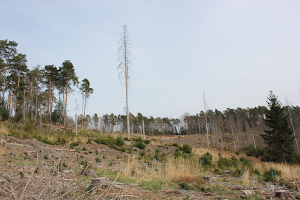Klimastabile Bäume in Deutschland pflanzen
Pflanzen Sie lokal hochqualitativen Mischwald und fördern Sie den Handprint. Ab 5.000 Bäumen werden eigene Firmenwälder am Wunschstandort realisiert.

Was wir bisher erreicht haben:
179k +
Bäume gepflanzt
501k +
Quadratmeter Wald geschützt
> 90
bepflanzte Flächen in Deutschland
Der Wald ist einer der wichtigsten, natürlichen Klimaschützer
Bäume sind unsere Verbündeten im Kampf gegen den Klimawandel: Sie speichern CO2, setzen Sauerstoff frei, speichern und filtern Trinkwasser und bieten einen Lebensraum für viel Tiere und andere Arten.
Doch den deutschen Wäldern geht es schlecht: Drei von vier Bäumen haben lichte Kronen. Die Folgen des Klimawandels haben dem Wald zugesetzt. Zum Schutz und Erhalt des Waldes setzen wir daher einen Impuls für klimastabile Mischwälder.

Unser Mitgründer Jan ist studierter Forst- und Agrarwissenschaftler und der interne Klimaförster bei Planted. Mit der richtigen Expertise kümmert er sich um die Auswahl der Flächen, die Zusammenarbeit mit den Waldbesitzenden und die Auswahl der klimastabilen Baumarten.


Welche Baumarten wir pflanzen, entscheidet sich für jede Fläche neu. Wichtig ist, dass die Baumarten mit den zukünftigen Veränderungen des Klimas klarkommen. Bisher haben wir unter anderem Hainbuchen, Esskastanien, Linden Stil- und Traubeneichen gepflanzt.


Wir pflanzen Mischwälder in ganz Deutschland. Die Flächen gehören Kommunen, Bundesländern und Privatpersonen. Wichtig ist für uns nur, dass der Wald für die Zukunft erhalten bleibt und seine Schutzfunktionen erfüllt.


Wieso wir Bäume in Deutschland pflanzen
Die Sicherheit der Pflanzung wird durch Expertise und Nachweise gewährleistet.
Maximale Qualität und Expertise durch den internen Klimaförster Jan Borchert.
Kontrollmechanismen durch Geokoordinaten für jeden einzelnen Baum.
Wälder können dank lokaler Flächen besucht werden, der Impact wird greifbar.
Unsere Waldflächen in Deutschland


























In der Pfalz haben wir auf verschiedenen Flächen gepflanzt, um dort den Mischwald zurückzubringen. Hier wachsen unter anderem Eichen, Weiden, Erlen und Tannen, die den Wald klimastabil erhalten sollen.

Green Marketing made easy

Höchste Transparenz durch digital teilbaren Firmenwald

Bester Support für Ihre Nachhaltigkeitskampagne
Bäume pflanzen und Unternehmensreputation steigern
Markenbindung
Umsatzsteigerung
Employer Branding
Mitarbeiterbindung


FAQ zum Mischwald
Unser Klimaförster Jan wählt spezifisch für jede Fläche die passenden Baumarten aufgrund der jeweiligen Flächenbedingungen. Dabei achtet er immer darauf, dass die Baumarten so klimastabil wie möglich sind, also zum Beispiel tief wurzeln, damit sie auch im Sommer gut an Wasser kommen. Die Überlebenschance unserer Bäume steht allein aus diesen Gründen bereits sehr gut. Die bepflanzten Flächen werden durch uns und Förster vor Ort regelmäßig kontrolliert und darauf geachtet, dass der geplante Wald auch wirklich entsteht.
Die Kompensation unvermeidbarer CO₂-Emissionen ermöglichen wir über zertifizierte Klimaschutzprojekte. Das Pflanzen der Bäume dient nicht der CO₂-Kompensation erfolgt bei Planted rein zusätzlich. Es fördert das Ökosystem Wald mit all seinen wichtigen Schutzunfktionen.
Der Bedarf, Wälder in Deutschland zu pflanzen, ist dringend, da der Klimawandel zu erheblichem Baumschwund geführt hat. Trotz rechtlicher Verpflichtungen sind die verfügbaren finanziellen Mittel oft unzureichend, um die notwendigen Aufforstungsprojekte angemessen zu finanzieren. Hier kommt Planted ins Spiel. Gemeinsam mit Unternehmen tragen wir dazu bei, die Wiederbewaldung voranzutreiben und den Verlust der Wälder auszugleichen. Nur so können wir den Herausforderungen des Klimanwandels zeitnah entgegenwirken.
Wir haben einen eigenen Förster an Bord, unter dessen Anleitung auch unser Planted Team regelmäßig Bäume pflanzt. So weiß das gesamte Planted Team, wie es geht, Bäume in Form von Mischwald zu pflanzen. Bei Projekten mit größerer Zahl an Bäumen wird die Pflanzung von professionellen Subunternehmen begleitet. Dazu haben wir Sponsoringverträge mit Bundesländern, Gemeinden und privaten Waldbesitzenden geschlossen. Teilnehmen können auch Mitarbeitende engagierter Unternehmen. Damit unsere Bäume behütet aufwachsen, besuchen wir unsere Projekte mehrmals im Jahr und tauschen uns regelmäßig mit unseren Partner-Wäldern aus.
Welche Baumart wir pflanzen, ist abhängig von dem Standort und wird für jede Fläche individuell entschieden. Unser Klimaförster Jan weiß, welche Bäume optimal für den jeweiligen Standort geeignet sind. Mit Planted pflanzen wir Mischwald, da dieser im Vergleich zu Monokulturen stabiler ist. Denn Monokulturen sind besonders anfällig für Hitze, Wind, Trockenheit und Insekten. Bisher haben wir unter anderem folgende Baumarten gepflanzt: Eiche, Hainbuche, Erle, Linde, Esskastanie, Kirsche und Tanne. Sie sind alle robust und wurzeln tief. Dadurch können sie im Sommer gut an Wasser gelangen und werden im Herbst nicht vom Wind umgeweht. Die Baumarten kommen mit den zukünftigen Bedingungen durch die Klimakrise gut klar, weswegen wir sie als klimastabile Baumarten bezeichnen.
Um richtig Bäume zu pflanzen und einen gesunden Wald zu fördern, ist es wichtig, geeignete Flächen sorgfältig auszuwählen und Mischwälder statt Monokulturen zu pflanzen. Auch die Auswahl der Baumarten sollte sich an den jeweiligen Flächengegebenheiten orientieren. Bäume können am besten in der kalten Jahreszeit in die Erde gesetzt werden, da sich die Bäume dort in der Ruhephase befinden und weniger aktiv wachsen. Es bedeutet weniger Stress für die Bäume. Die Bäume haben zudem bessere Bewurzelungschancen, brauchen weniger Bewässerung und haben ein geringeres Risiko für Schädlingsbefall.








